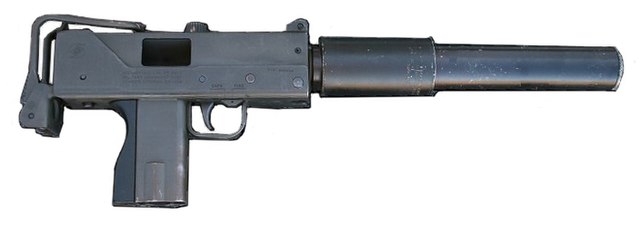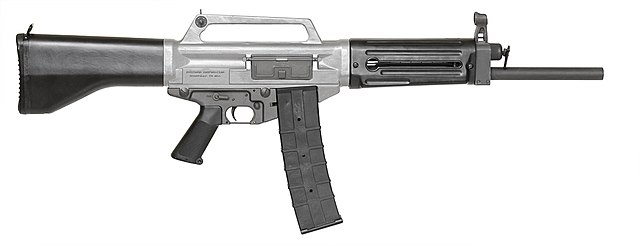Loading AI tools
Class of weapons under the National Firearms Act From Wikipedia, the free encyclopedia
Title II weapons, or NFA firearms, are designations of certain weapons under the United States National Firearms Act (NFA).

These are weapons requiring a Type 01 Federal Firearms License (FFL) as well as a Class 3 Special Occupation Tax (SOT) to sell, and an ATF Form 4 (transfer of registration) with $200 tax stamp to purchase. Also a Type 07 FFL (manufacturer) with a Class 2 Special Occupation Tax is qualified to manufacture, purchase and sell. [1] The restrictions apply to certain firearms, explosive munitions, and other devices which are federally regulated by the NFA.[2][3] Any violation of the NFA is a felony punishable by up to 10 years in prison.[4] Per the National Rifle Association's Summary of Gun Control Act of 1968:[5]
Title II of the Gun Control Act of 1968 is a revision of the National Firearms Act of 1934, and pertains to machine guns, short or "sawed-off" shotguns and rifles, and so-called "destructive devices" (including grenades, mortars, rocket launchers, large projectiles, and other heavy ordnance). Acquisition of these weapons is subject to prior approval of the Attorney General, and federal registration is required for possession. Generally, a $200 tax is imposed upon each transfer or making of any Title II weapon.
The Bureau of Alcohol, Tobacco, Firearms, and Explosives (ATF), which enforces federal firearms law, refers to such weapons as "NFA firearms".[6] NFA firearms include machine guns, short-barreled rifles and shotguns, heavy weapons, explosive ordnance, silencers and "any other weapon" (AOW), such as disguised or improvised firearms.[3] Title I weapons, or GCA firearms, are standard rifles, shotguns, and handguns.
Explosive devices such as bombs or grenades are regulated as NFA firearms (destructive devices). Explosive materials are not considered NFA firearms; they are regulated under the Organized Crime Control Act.[7]
A machine gun, as defined in the NFA, is "Any weapon which shoots, is designed to shoot, or can be readily restored to shoot, automatically more than one shot without manual reloading, by a single function of the trigger." The NFA term machine gun refers to all firearms capable of full automatic fire and includes true machine guns, submachine guns, and machine pistols. The frame or receiver of a machine gun, and any combination of parts intended to make a machine gun, is legally defined as a machine gun.[8] For example, according to the ATF, "A Glock Switch is a part which was designed and intended for use in converting a semi-automatic Glock pistol into a machine gun; therefore, it is a "machine gun" as defined in 26 U.S.C. 5845(b)." Open-bolt firearms made after 1982 are considered machine guns due to ease of conversion.[9]
Parts that can be used to convert a semi-automatic firearm to fully automatic capability are regulated as machine guns and must be registered and tax paid under the NFA. The U.S. military issued kits T17 and T18 to convert the M1 carbine to an M2, capable of fully automatic fire; these kits are legally "machine guns".[10]
A short-barreled shotgun (SBS) is defined as:[11]
(1) a shotgun having a smoothbore barrel or barrels of less than 18 inches [46 cm] in length;
(2) a weapon made from a shotgun if such weapon as modified has an overall length of less than 26 inches [66 cm] or a barrel or barrels of less than 18 inches in length [...]
It must be intended to be fired from the shoulder one shell of shot (pellets) or one projectile at a time.[12]
A short-barreled rifle (SBR) is defined as:[13]
(3) a rifle having a rifled barrel or barrels of less than 16 inches [41 cm] in length;
(4) a weapon made from a rifle if such weapon as modified has an overall length of less than 26 inches or a barrel or barrels of less than 16 inches in length [...]
A rifle is a firearm designed to be fired from the shoulder and fire one bullet at a time through a rifled barrel.[14] An SBR need not retain a shoulder stock after modification.
ATF regards pistols with shoulder stocks as redesigned to be fired from the shoulder. Modern pistols with shoulder stocks and with barrels less than 16 inches (41 cm) long, or overall length under 26 inches (66 cm), are NFA short barrelled rifles. ATF has removed some specified stocked handguns (e.g., original Mauser C96 and Luger utilizing an original shoulder stock) from the NFA as collectors' items (Curios or Relics List);[15] ATF treats them as pistols under the GCA.[16]

There are two categories of destructive devices (DDs):[17]
Most commercial shotguns have a bore diameter greater than 1⁄2 inch, but are exempt due to their "sporting purpose"; however, both the Street Sweeper and USAS-12 shotguns, designed for military or police use, were reclassified as DDs when the ATF determined they were combat shotguns not "generally recognized as particularly suitable for sporting purposes".
Devices which are not intended or not likely to be used as a weapon are also exempt. Examples of non-weapon large bore firearms include:
Fireworks are non-weapon explosive ordnance.
Flare launchers are normally exempt as they are signalling devices, not weapons; however, possession of a flare launcher and anti-personnel ammunition for it puts it in the DD category as it is then considered to be a weapon.
The legal term silencer, also known as a "suppressor", is defined as "any device for silencing, muffling, or diminishing the report of a portable firearm, including any combination of parts ... intended for use in assembling or fabricating a firearm silencer."[18]


"Any other weapon" is a "catch-all" category. An AOW is defined as "any weapon or device capable of being concealed on the person from which a shot can be discharged through the energy of an explosive," other than a handgun with a rifled barrel.[3] This umbrella definition includes many improvised firearms ("zip guns") and disguised firearms. Examples include wallet guns, cane guns, knife guns and pen guns.[19] An AOW can be transferred to non-prohibited persons with a $5 BATF stamp as opposed to the $200 stamp required for machine guns and short-barreled rifles.
AOW is a complex and often misunderstood category of NFA firearms. Less obvious examples of AOW devices include:
An antique firearm is excluded from NFA regulation if it is "not likely to be used as a weapon" and is not a machine gun or destructive device.[3] It must have been manufactured before 1899:
18 USC 921 (a)(16). (A) any firearm (including any firearm with a matchlock, flintlock, percussion cap, or similar type of ignition system) manufactured in or before 1898; and (B) any replica of any firearm described in subparagraph (A) if such replica -- (i) is not designed or redesigned for using rimfire or conventional centerfire fixed ammunition, or (ii) uses rimfire or conventional centerfire fixed ammunition which is no longer manufactured in the United States and which is not readily available in the ordinary channels of commercial trade.
Note that a firearm manufactured before 1899 is an antique by nature of production date. A replica is of the same status provided it is either a muzzle loader, uses non-fixed ammunition (such as pinfire cartridges), or custom ammunition not commercially produced (such as conversion cartridges). Note that ATF has not defined "commercial production" for quantities of ammunition to qualify as "readily available".
The ownership of Title II weapons is not illegal, but is heavily regulated at both the State and Federal level.[25] Numerous federal restrictions are imposed on the ownership of NFA firearms, including an extensive background check initiated by the applicant's local police department or Sheriff's office. In most states, certification of the local background check is discretionary ("May-Certify"), meaning the law enforcement agency charged with initiating the background check may deny certification of the background check either arbitrarily or for reasons unrelated to the information obtained from the background check, or refuse to accept applications to start the background check process. Some states have passed "Shall-Certify" legislation requiring local law enforcement agencies to process and certify applications for those who pass the initial background check. A few states completely outlaw private citizens from obtaining NFA Title II weapons ("No-Certify").
Federal law imposes a $200 tax on manufacture or certain transfers of an NFA firearm, and a requirement for registration under the NFA. Generally, for the manufacture of NFA items, ATF Form 5320-1 must be submitted to the ATF. For the transfer of a NFA item from a person or entity lawfully entitled to transfer it (Class 3 dealer) to oneself, or an entity (Gun Trust or LLC), the ATF Form 5320-4 must be submitted to the ATF. There is a lower, $5 transfer tax for weapons that fit in the definition of "Any Other Weapon" (AOW). Any violation of the NFA is a felony punishable by a fine of up to $250,000 and up to 10 years in prison,[4] and any firearm involved is forfeit.[26]
Of NFA firearms (silencers, machine guns, short barrel rifles, short barrel shotguns, any other weapon (AOW) and destructive devices) machineguns are the most restricted. Since 19 May 1986, no new machineguns can be registered for private ownership.
A few states, such as New York, Delaware, and California, prohibit ownership of all or certain types of Title II weapons and devices. Most states allow legal ownership if the owner has complied with the federal registration and taxation requirements. A few states only allow possession of NFA firearms on the ATF Curios and Relics List, again only if the owner has complied with all federal requirements.
Seamless Wikipedia browsing. On steroids.
Every time you click a link to Wikipedia, Wiktionary or Wikiquote in your browser's search results, it will show the modern Wikiwand interface.
Wikiwand extension is a five stars, simple, with minimum permission required to keep your browsing private, safe and transparent.